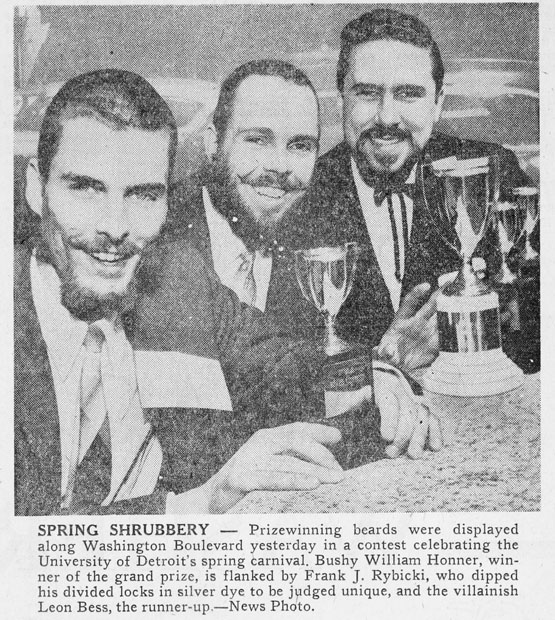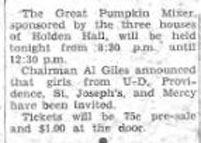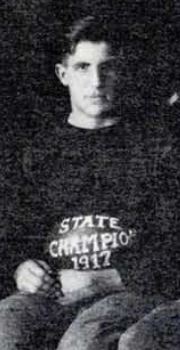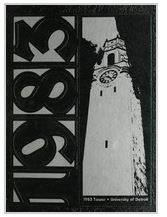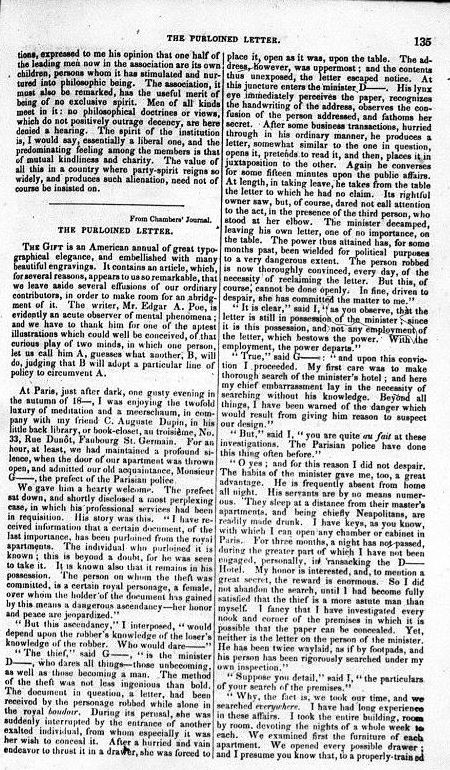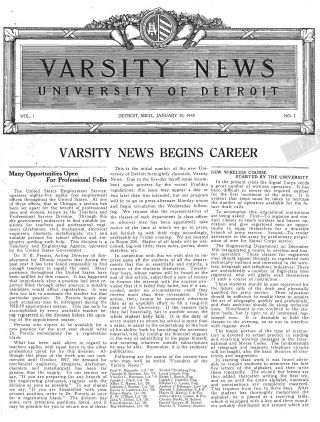No Shave November
For several years back in the 50′s, the University of Detroit Spring Carnival held a beard contest. There were categories such as Full, Unique, Van Dyke and a Special Award to the best recreation of an historical beard. The prizes included Remmington Shavers and Grooming kits by Remmington. Afterwards (back on campus) there would be a shaving contest in which there was a footrace (20 yards) to the judges stand to line up for the smoothness test by King and Queen of the Carnival.
Photo from Detroit News, May 5(?), 1958
The Great Pumpkin at UD 1961
The Great Pumpkin Mixer, October 31, 1961


 Not a “publicity stunt”? Hmmmmm. Next to this article there just happens to be:
Not a “publicity stunt”? Hmmmmm. Next to this article there just happens to be:
Varsity News, October 31, 1961
Have a Safe and Happy Halloween!
Headache Cure
Headache Cure
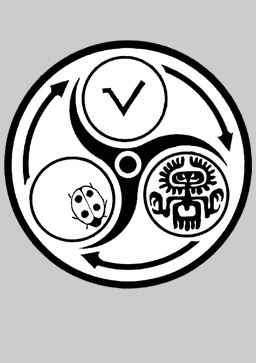 The James T. Callow Folklore Archive is an interesting place to spend some time. A visitor can usually discover something interesting, funny, or amazing there. Each entry is brief but loaded with a bit of America that few other collections offer.
The James T. Callow Folklore Archive is an interesting place to spend some time. A visitor can usually discover something interesting, funny, or amazing there. Each entry is brief but loaded with a bit of America that few other collections offer.
Take this post, for example. I was searching for something to write about and typed a few lines into Google to see what I could find. To my delight, this brief story from the collection popped onto the page:
TILLIE VOSS WAS THE HUGE FOOTBALL PLAYER FOR THE UNIVERSITY OF DETROIT IN THE YEAR OF ABOUT 1926. ONE DAY HE HAD A TERRIBLE TOOTHACHE (SO THE STORY WAS TOLD FROM MY FATHER HOWARD PHILIPPART, THE FULLBACK FOR U OF D). ASPIRIN DID NOT SEEM TO HELP AND HE DESPERATELY NEEDED SLEEP FOR THE BIG NAVY GAME THE FOLLOWING DAY. “I GOTTA DO SOMETHING,” HE TOLD MY FATHER AND RAN FULL TILT HEAD FIRST INTO THE CINDER BLOCK WALL. AS THEY CARTED HIM OFF TO BED FOR A GOOD NIGHT SLEEP, THE PLAYERS SILENTLY APPLAUDED HIS DEDICATION AND LOYALTY.
This, to me, is why the term “holy moly” was invented. The U of D football players of the 1920s were indeed solidly built and … um, “head strong”!
The introduction to The James T. Callow Folklore Collection tells the reader more about this unique archive:
“The University of Detroit Mercy Digital Folklore Archive, founded in 1964 by Professors Frank M. Paulsen and James T. Callow was donated to the University of Detroit Mercy Libraries /Instructional Design Studio in 2009. The archives is comprised at this point of over 42,000 folklore traditions taken from field notes gathered by UDM (formerly University of Detroit) students as part of their course work in ‘Introduction to Folklore,’ ‘Studies in Folklore,’ ‘Folk Groups,’ and ‘Folklore Archiving.’ The folklore archive covers traditions gathered between 1964 and 1993. Included in the Archive is the Peabody field note collection containing approximately 12,000 entries from Tennessee and the Southeast.”
Sounds interesting, right? To discover more, visit this wonderful archive by clicking here.
Contributed by Linda Papa, Digital Technician
A View of Past Presidential Elections
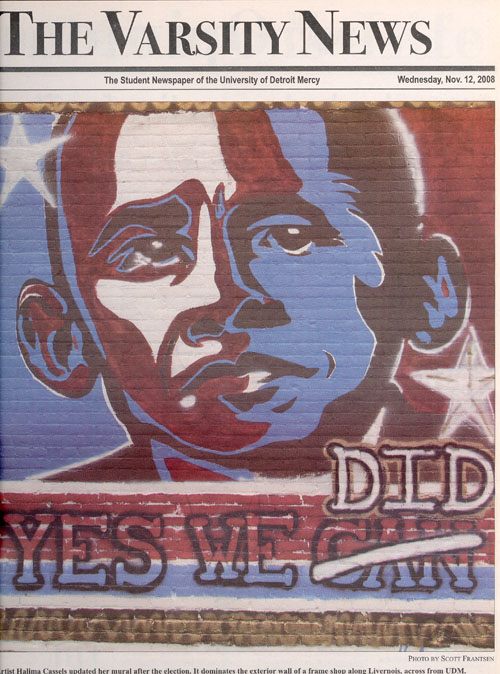 The following viewpoints are not necessarily those of the University of Detroit Mercy or that of the employees of the university or library. I thought I better put that disclaimer in just in case-I don’t want anyone to think that any political bias that might get expressed here reflects on anyone but me.
The following viewpoints are not necessarily those of the University of Detroit Mercy or that of the employees of the university or library. I thought I better put that disclaimer in just in case-I don’t want anyone to think that any political bias that might get expressed here reflects on anyone but me.
While college students came out in significant numbers to support the election of President Obama in 2008 and 2012, that seems to be more the exception than the rule when it come to college students role in presidential elections in the past. Clinton does not seem to be inspiring the students to vote for her and Trump might be discouraging students not to vote at all.
Just as a quick check on what was being reported in the student newspapers just before a presidential election, here are a few observations from the Varsity News:
- 1960-Kennedy vs Nixon: Outside of a few editorials and news items about activities of Republican and Democratic student organizations, not a lot of articles about the election. About the only voting item being mentioned is for Homecoming Queen. (Bet Mr. Trump would have liked to have had a chance to vote in that contest!)
- 1964-Johnson vs Goldwater: UD held a mock election. Johnson (Democrat) won 501-301. There was also a Michigan governors race that year, Romney (Republican) won over Neil Steabler 608-169. Must have been a lot of ticket splitters that year.
- 1968-Nixon vs Humphrey vs Wallace: If it were not for a big front page article on October 29th issue, on a visit by Humphrey’s wife Muriel to the Detroit area, you might not even know that it was an election year!
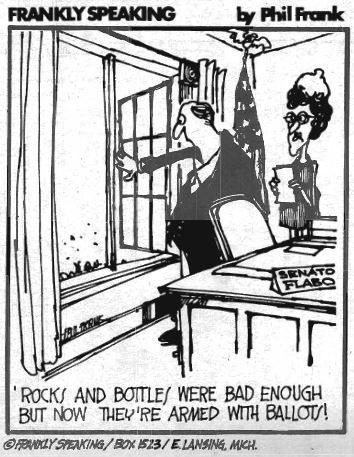
- 1972-Nixon vs McGovern: At least in this year, the Varsity news ran quite a few political items to inform the students of the positions of the presidential candidates. It was the first national election that 18-year-olds were given the right to vote by the 26th Amendment. Not surprising with the conflict still going on in Vietnam, the student newspaper endorsed McGovern for president.
- 1976-Carter vs Ford vs McCarthy: Wish I could tell you, but we have no Varsity News for the 76-77 school year. If you have any, send them to us!
- 1980-Reagan vs Carter vs Anderson: There was a mock election held by the Political Science Association (student organization). Jimmy Carter won a plurality of the vote (42 percent). It was not a big turnout. Of the ballots cast, Carter received 54, Reagan second with 33, and Anderson placed third with 29. Thirteen ballots were marked for “somebody else” which included Barry Commoner of the Citizens Party, Gus Hall, communist candidate, Libertarian candidate Ed Clark and Andrew Pulley of the Socialist Workers Party. (Wonder how many “somebody else” votes will get in this years election!)
- 1984 and 1988 election coverage by the student newspaper seem pretty routine with articles about the candidates and their positions.

- 1992-Clinton vs Bush vs Perot: Most of the articles were very much like previous years, but they did publish a Detroit Mercy poll of the students. Interesting how Clinton is such an overwhelming favorite of the female students. Bush and Perot never had a chance. Anyone want to make any guesses on how the women will vote this year?
The remaining election years reported in the Varsity News have the usual articles you would find in a newspaper. Would have liked more polls of the students to see how it might match the vote with the rest of the nation.
Whatever your political leanings might be, I hope you will go out and vote.
“Our Wish is to Do Good”
 The Colored American was among 40 black newspapers published before the Civil War. Although it’s first issue was available in March of 1837, it was the July 7, 1838 (shown here), issue that offered a pointed expression of its purpose and direction.
The Colored American was among 40 black newspapers published before the Civil War. Although it’s first issue was available in March of 1837, it was the July 7, 1838 (shown here), issue that offered a pointed expression of its purpose and direction.
Like all such newspapers in circulation at the time, the Colored American offered a way to keep people connected and informed. It offered them a voice and a platform for debate when no other resource was available. And though various sources disagree on the years of its publication (originally from 1837 to 1842), it made a significant impact on those who would fight for freedom.
In the article shared here, the writer informs his readers that the newspaper’s intention is simply “to do good in the community and to assist an oppressed segment of society.” There were always disagreements and debates, both political and ethical, even in this tightly knit group of people. The newspaper offered the perfect way to present both sides of issues to encourage readers to draw their own conclusions and make informed choices. And while the readership consisted mostly of free, literate African Americans, both the free and the enslaved were affected by the topics addressed in the articles.
Contribution by Linda Papa, Digital Technician
Fall Homecoming 2016
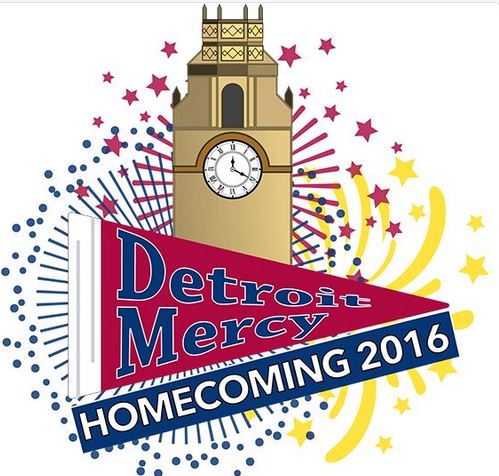 This year the University of Detroit Mercy is going all out to celebrate a fall homecoming for students and alumni. There will be a campus-wide BBQ, 5K race, an old fashion tug-of-war that was an annual event with the St. Francis Club, and since many alumni met their future spouses when they were students at the university, a ceremony to renew their vows. There are a number of other events scheduled for the weekend-its just too bad that it looks like rain over the weekend might force some of the outdoor activities indoors.
This year the University of Detroit Mercy is going all out to celebrate a fall homecoming for students and alumni. There will be a campus-wide BBQ, 5K race, an old fashion tug-of-war that was an annual event with the St. Francis Club, and since many alumni met their future spouses when they were students at the university, a ceremony to renew their vows. There are a number of other events scheduled for the weekend-its just too bad that it looks like rain over the weekend might force some of the outdoor activities indoors.
For those who were not able to attend homecoming, the library has other means to help you remember “the good ol’ days”. The library has digitized many of the publications that have been produced over the years by and for students of Mercy College and University of Detroit. They include:
Mercy College of Detroit Student Newspaper
Bulletins and Course Catalogs of both institutions
Dichotomy:School of Architecture Student Journal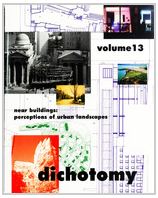
So if you can’t make it to the homecoming, the library will try and bring it to you!
Edgar Allan Poe’s Purloined Letter
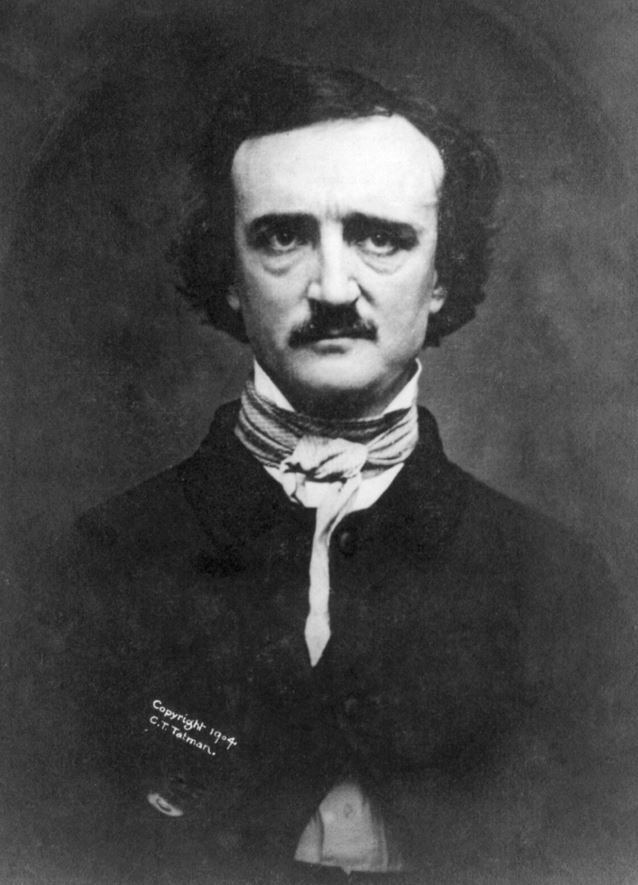 This post is more of a sidebar of what else I do in the archives and special collections. In the process of weeding material out of the regular circulating collection, I go through the material to see if there are any items that are worth finding new homes for instead of sending to some landfill. “One man’s trash is another man’s treasure” is the case with many of the items that I have posted on the library’s ebay page. I have one regular customer who likes to pick up any material I post on automotive or engineering type of books, even though they are old and outdated. He does not seem to mind that he has to pay outrageous shipping cost to ship to Spain! The money I get from the sales goes back into the library and I use it to pick up items for the archives related to the University of Detroit Mercy. I have picked up items that fill holes in our collection (old football programs), memorabilia (mugs, banners, decals) and things that who knew even existed like junior prom gifts given to students for attending the event.
This post is more of a sidebar of what else I do in the archives and special collections. In the process of weeding material out of the regular circulating collection, I go through the material to see if there are any items that are worth finding new homes for instead of sending to some landfill. “One man’s trash is another man’s treasure” is the case with many of the items that I have posted on the library’s ebay page. I have one regular customer who likes to pick up any material I post on automotive or engineering type of books, even though they are old and outdated. He does not seem to mind that he has to pay outrageous shipping cost to ship to Spain! The money I get from the sales goes back into the library and I use it to pick up items for the archives related to the University of Detroit Mercy. I have picked up items that fill holes in our collection (old football programs), memorabilia (mugs, banners, decals) and things that who knew even existed like junior prom gifts given to students for attending the event.
When I get old journals that I have never heard of, I have to do a little research to know what kinds of subjects it covered. Such was the case with a journal titled “Living Age”. In trying to find out more about this title, which turns out to have the full title “Littell’s Living Age”, someone had noted that it has the second appearance of Edgar Allan Poe’s story “The Purloined Letter”. The problem was, I had my journals all on microfilm, which required a little more digging around the internet so I would not have to scroll through all the film to see it for myself. I eventually found a site that listed the contents of the journal.
Like many writers, such as Thomas Hardy, Charles Dickens, and H.G. Wells, in that time period (1800′s to early 1900′s), the first publication of their works were serial publications through magazines. When I had paper copies of those to post, I had no problems finding bidders who would bid against each other for those “First Editions”.
When it comes to old journals, my own personal holy grail is to find Vol. 1 of “The Ring”, which is a boxing magazine. When we weeded the collection of that title which started with Vol. 1, 1922-WOW. The winning bid was over $3,000 for just the first volume! Apparently it is very rare to find a complete set of 12 issues in good condition of volume one. I have not had anything since then come even close to that bid.
So while a lot of material is being digitized and made available through the internet, there is a lot of stuff that is NOT online. As long as there are things available only on paper or in some kind of physical artifact, the archives are not going to go away anytime soon.
Birth of a Student Newspaper, Part 2: Outer Echoes
Outer Echoes Still Heard
In 1940, the Sisters of Mercy established a presence in Detroit at Southfield and West Outer Drive. About a year later, Mercy College of Detroit began offering classes on this spot that would leave an indelible mark in this city’s history. Over the years until its consolidation with the University of Detroit in 1990, Mercy College expanded from offering nursing and teaching classes to women into a comprehensive coeducational liberal arts college.
In October 1941, the first issue of the Mercy College newspaper, then called “Outer Echoes,” was published. The first column on the first page of this issue welcomed the first classes to this new college on September 8, of that year. Even in its publication infancy, this first issue is loaded with information regarding the beginning of this new institution of higher learning. We can read about the dedication ceremonies, along with details of the elections and activities involved with the opening of a new college. We can see who was chosen for each important aspect of the governing of this new institution, along with photos of the bright faces of those who could consider themselves the first students in what would become such an influential school for those to follow. On page 3, we get a glimpse into one of the dorm rooms at “McAuley Lodge” (the residence building at the time), along with a brief description of campus life written by excited freshmen.
Four pages of history are here in this issue of the Mercy College Newspapers digital collection for your review. It’s worth the time just to look at the photos! But linger a while in these pages, and I think you’ll be pleased by the treasure you’ll find.
Contributed by Linda Papa, Digital Technician
The Birth of a Student Newspaper: Varsity News
In 1918, while the country was focused on the misery of WWI and the devastation of the Spanish influenza epidemic (said to be the worst in U.S. history) there was a desperate need for a reliable distribution of information. With so much upheaval and uncertainty, newspapers around the country offered a way to connect individuals with vital details concerning the seemingly fast moving changes taking place in the world. The value of this form of communication was also recognized by the University of Detroit, and in that year (on January 30), the Varsity News was born.
It wasn’t only that the need was there to connect U of D’s growing student and faculty population, however. There’s something of the essence of community included with being part of a university that can’t be expressed in any way other than a newspaper.
With all the digital advancements taking place these days, it’s really interesting to note that the Varsity News in its original form endures. This is more than just entertainment or even communication … this is about representing in tangible form the whole of the university’s existence. A newspaper unites, includes, expresses and helps provide an identity to who we are.
There’s a difference between providing information and communicating with readers. The News offers that connection, that communication, and that relationship feels more like a handshake than a memo. Behind every one of the articles is a student who has stood in the shoes of each and every reader, who knows those eyes that peruse the page.
Sydney J. Harris, American journalist, once said, “Information is giving out; communication is getting through.” The Varsity News, from its beginning until now, offers great communication.
See more issues of the Varsity News in our digital archive.
Contribution by Linda Papa, Digital Technician



